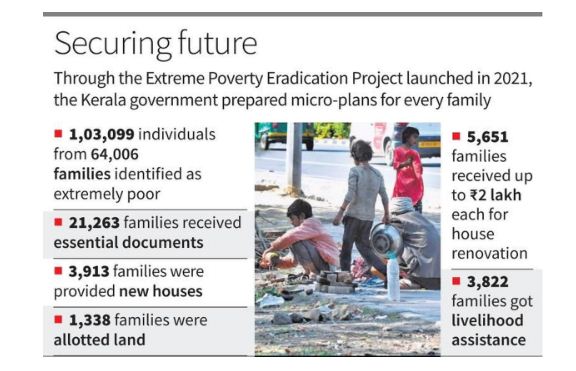November 4, 2025
Kerala Piravi Day : Project of Extreme Poverty Eradication (EPEP)
Why is it in News? On November 1, 2025 – Kerala Piravi Day – Chief Minister Pinarayi Vijayan announced in the assembly that Kerala has completely removed all extreme poverty and that it is the first Indian state to eradicate extreme poverty! The announcement marked the end of the Implementation of the Project of Extreme Poverty Eradication (EPEP), which was initiated in 2021, and was framed as a major “social welfare” achievement.

Claim of Kerala:
The Government stated that it has removed a claimed 64,000 “extremely poor” families across the state using EPEP surveys. These families claimed to lack safe housing, food, income, and access to the healthcare system. The Government stated that through a specific intervention of housing, livelihood supports, and connections to welfare supports, they lifted these households out of poverty. The state therefore declared they were “poverty-free.”
Actions Taken:
- Surveys and Identification: Local bodies (Gram Panchayats) identified the most marginalised families based on observable poverty indicators.
- Convergence of Schemes: These families were connected to multiple welfare schemes – the Life Mission for housing, Kudumbashree for livelihood, Arogya Kiranam for health, and social pensions.
- Role of Local Government: The panchayat was responsible to monitor progress and benefits to benefit households.
- Inclusion: There were significant efforts to include marginalised populations such as scheduled tribes and coastal communities.
Issues and Critiques:
- Narrow Definition: The term “extreme poverty” has excluded many families in precarious situations but not destitute.
- Managerial Approach: Success was defined as the absence of names on a list, not as the presence of dignity and opportunity.
- Temporary Relief: Many interventions were single supports, not structural interventions that addressed job security or inequality.
- Political Purpose: Declaring poverty to be eradicated produces complacency and a weakened demand for redistributive action.
- Inequality Unaddressed: Landlessness among Dalit and Adivasi, precarious informal employment, and regional disparities are inequality issues that remained unaddressed.
Way Forward:
- Embrace a rights-based, multidimensional understanding of poverty beyond material deprivation.
- Build the social protection system to be universal and expand decent employment.
- Begin to correct structural inequities, starting with equity of access to land, education, and healthcare.
- Ensure participatory governance, keeping local bodies at the center of decision making.
- Sustain monitoring and evaluation to prevent backslide and sustain social benefit gains.
Conclusion:
Kerala’s declaration is a historic, symbolic, and administrative victory and is the worthy culmination of a series of welfare-oriented decisions. In order for the state to legitimately declare the end of poverty, it must confront and address the inequalities that contribute to poverty and marginalization. In order to maintain the moral significance of the Kerala model to the state, the policy horizons must grow beyond the narrow line of data-driven success and affirm an orientation towards justice, dignity, and inclusive development.
October 17, 2025
October 16, 2025
October 6, 2025
September 24, 2025
